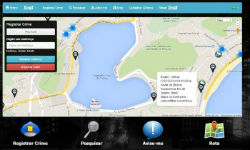A new smartphone application from Brazil maps where various types of crimes occurred and offers users the safest route home, in just one example of how the technology provided by mobile devices is being used to improve citizen security in Latin America.
The application, called Smaps, allows users to report where crimes — ranging from murder and kidnapping to vandalism — are taking place in real time, and notifies other registered users of the update. Using this shared information database, the app can map out the safest route to a given user’s final destination, and can also identify the nearest police station (see video below).

Although Smaps was developed in Brazil, it can be used internationally. The app currently has the largest amount of data on major cities like Rio de Janeiro and São Paulo, according to O Globo. The app’s developer, Douglas Roque, reportedly plans to expand the site’s database by including publicly available crime information from local government sources in addition to civilian-reported crimes.
Smaps is just one smartphone application aimed at improving citizen security in Brazil. The “CopCast” app, part of the Smart Policing initiative developed by Brazilian think tank the Igarape Institute, allows senior police officials to monitor officers on patrol using an interactive, real time map. CopCast can also store videos from police body cameras for up to 90 days.
SEE ALSO: Coverage of Police Reform
Two goals of Smart Policing are to increase accountability for police officers who use excessive force and to protect police from unfounded allegations of abuse. The Military Police of Rio de Janeiro is a contributing partner in the project, which is currently being tested with Police Pacification Units (UPP) in Rio.
The Igarape Institute is also developing the Child Security Index (CSI), which, via a smartphone app, “spatially maps and graphically visualizes how young children experience violence in poor neighborhoods” in Brazil. The CSI achieves this by using the app to survey children about their perceptions of danger and, based on their responses, creating interactive charts and maps that identify where children feel most at risk (see image below).

According to Robert Muggah, the Research Director and Program Coordinator for Citizen Security at Igarape, the CSI is intended to fill a “knowledge gap” on how children under age 10 experience violence. There are also plans for the CSI to measure the effectiveness of youth intervention programs that promote child security — such as Schools for Peace in Rio — by periodically measuring how survey responses from children in these programs change over time.
Security-themed smartphone apps are taking hold in many parts of Latin America outside Brazil as well. Apps available in countries including Mexico, Venezuela, Peru, and Colombia can instantaneously connect users with police stations in emergency situations. This app is evidently already paying off in Peru: the head of citizen security in Lima’s Surco district reported crime went down 40 percent between January — when the app went into effect — and March this year.
InSight Crime Analysis
The growing popularity of these security apps in the region is indicative of their potential to transform how individuals protect themselves. Using a mobile device to instantly communicate with the police or map out the safest route home are options that were, until recently, unimaginable.
The Igarape Institute is one of Latin America’s pioneers in this regard. In addition to the Smart Policing initiative and the CSI, Igarape has also partnered with Google to create an interactive map of worldwide arms trafficking trends. “We brought in a bunch of engineers and software programmers, not just to stick in a back office, but actually to integrate into our team. These guys have become part of the DNA of what we do,” Muggah told InSight Crime.
Nevertheless, many smartphone applications geared toward citizen security in Latin America are still in their initial phases, and there appears to be little hard data available about their effectiveness in reducing crime.
There are bound to be some limitations to these tools. For example, cultures of violence are difficult to overcome, and there is no guarantee technologies like CopCast will reduce police brutality in Brazil if those in charge fail to report cases of abuse. The brazen capture and killing of a teenage suspect by military police in Rio this summer — despite the fact that cameras inside the squad car filmed the events before and after the execution — points to the level of impunity Brazilian police perceive themselves as having, which could undermine the effectiveness of technological tools aimed at deterring these kinds of actions.
SEE ALSO: Brazil News and Profiles
These technological advances also raise questions on where to draw the line between security and privacy.
“The debate about the balance between public safety and individual privacy is much more advanced in North America than it is in Latin America,” Muggah said. This is a debate that will be necessary to have if states in the region are to harness the full security potential of smartphone apps.
Smartphone apps will undoubtedly continue to evolve, providing new avenues for security in the region. Applications like the CSI and Smaps are already more advanced and interactive than some of their predecessors like “Mi Policia” in Mexico, which allows users to rapidly locate and communicate with the nearest police station. A diverse range of actors — from government agencies to private businesses and NGOs — have begun utilizing apps and various other forms of technology to improve security in the region, and this trend is set to continue.

